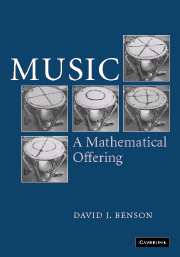 Back to Dave Benson's front page
Back to Dave Benson's front page
 Back to Dave Benson's front page
Back to Dave Benson's front page

The current online version (14 December 2008) is available FREE in
pdf format here:
music.pdf (10 megabytes, 531 pages).
Please read further down about differences from print version.
I have noticed many people putting old versions of this text online, especially
on the usenet group alt.binaries.e-book.technical:
PLEASE, PLEASE don't do this. The text is regularly updated, and your version is almost
always out of date, sometimes by several years.
Finally, I get a large volume of email about this book. If I don't answer
yours personally, please don't get offended.
UK: Hardback £65 / Paperback £26
USA: Hardback $126 / Paperback $48
AUS: Hardback A$225 / Paperback A$80
Can be obtained directly from CUP online (above) or bookshop (tel. 01223-333333);
or from
Amazon UK £25.99;
Amazon USA $44.10;
Amazon FR €29,38;
Amazon DE €32,99;
Amazon CA CDN$43.96;
Amazon JP ¥5,213.
A review of the book appears in the February 2007 issue (#276) of
The Wire, just a few pages away from
a review of a concert by Iggy Pop. Must be the first time I've
been featured in the same magazine as Iggy! Could it be a first for him too?
You never know.
Also reviewed by
American Scientist 95 (4) 2007,
Maths Reviews, Nov 2007,
The Mathematical Intelligencer, Vol 30 No 1 (2008), 76-77
and
The London Mathematical Society, Newsletter 363, Oct 2007
CUP have granted me permission to keep an updated version of the book online in its entirety, even after publication, so the pdf file will continue to be available on this site, and will continue to be updated periodically. No online version will ever be identical to the published version; each has material not contained in the other. For example, the online version keeps and continues to update material of a more ephemeral nature such as links to online resources, and some extensive tables not suitable for a published book.
Beware that the online version continues to evolve, so that references
to it will always be unstable.
References should be made to the print edition instead.
Current Chapter Headings (online version):
1. Waves and harmonics
1.1 What is sound?
1.2 The human ear
1.3 Limitations of the ear
1.4 Why sine waves?
1.5 Harmonic motion
1.6 Vibrating strings
1.7 Sine waves and frequency spectrum
1.8 Trigonometric identities and beats
1.9 Superposition
1.10 Damped harmonic motion
1.11 Resonance
2. Fourier theory
2.1 Introduction
2.2 Fourier coefficients
2.3 Even and odd functions
2.4 Conditions for convergence
2.5 The Gibbs phenomenon
2.6 Complex coefficients
2.7 Proof of Fejér's theorem
2.8 Bessel functions
2.9 Properties of Bessel functions
2.10 Bessel's equation and power series
2.11 Fourier series for FM synthesis and planetary motion
2.12 Pulse streams
2.13 The Fourier transform
2.14 Proof of the inversion formula
2.15 Spectrum
2.16 The Poisson summation formula
2.17 The Dirac delta function
2.18 Convolution
2.19 Cepstrum
2.20 The Hilbert transform and instantaneous frequency
2.21 Wavelets
3. A mathematician's guide to the orchestra
3.1 Introduction
3.2 The wave equation for strings
3.3 Initial conditions
3.4 The bowed string
3.5 Wind instruments
3.6 The drum
3.7 Eigenvalues of the Laplace operator
3.8 The horn
3.9 Xylophones and tubular bells
3.10 The mbira
3.11 The gong
3.12 The bell
3.13 Acoustics
4. Consonance and dissonance
4.1 Harmonics
4.2 Simple integer ratios
4.3 Historical explanations of consonance
4.4 Critical bandwidth
4.5 Complex tones
4.6 Artificial spectra
4.7 Combination tones
4.8 Musical paradoxes
5. Scales and temperaments: the fivefold way
5.1 Introduction
5.2 Pythagorean scale
5.3 The cycle of fifths
5.4 Cents
5.5 Just intonation
5.6 Major and minor
5.7 The dominant seventh
5.8 Commas and schismas
5.9 Eitz's notation
5.10 Examples of just scales
5.11 Classical harmony
5.12 Meantone scale
5.13 Irregular temparaments
5.14 Equal temperament
5.15 Historical remarks
6. More scales and temperaments
6.1 Harry Partch's 43 tone and other super just scales
6.2 Continued fractions
6.3 Fifty-three tone scale
6.4 Other equal tempered scales
6.5 Thirty-one tone scale
6.6 The scales of Wendy Carlos
6.7 The Bohlen-Pierce scale
6.8 Unison vectors and periodicity blocks
6.9 Septimal harmony
7. Digital music
7.1 Digital signals
7.2 Dithering
7.3 WAV and MP3 files
7.4 MIDI
7.5 Delta functions and sampling
7.6 Nyquist's theorem
7.7 The z-transform
7.8 Digital filters
7.9 The discrete Fourier transform
7.10 The fast Fourier transform
8. Synthesis
8.1 Introduction
8.2 Envelopes and LFOs
8.3 Additive synthesis
8.4 Physical modeling
8.5 The Karplus-Strong algorithm
8.6 Filter analysis for the Karplus-Strong algorithm
8.7 Amplitude and frequency modulation
8.8 The Yamaha DX7 and FM synthesis
8.9 Feedback, or self-modulation
8.10 CSound
8.11 FM synthesis using CSound
8.12 Simple FM instruments
8.13 Further techniques in CSound
8.14 Other methods of synthesis
8.15 The phase vocoder
8.16 Chebychev polynomials
9. Symmetry in music
9.1 Symmetries
9.2 The harp of the Nzakara
9.3 Sets and groups
9.4 Change ringing
9.5 Cayley's theorem
9.6 Clock arithmetic and octave equivalence
9.7 Generators
9.8 Tone rows
9.9 Cartesian products
9.10 Dihedral groups
9.11 Normal subgroups and quotients
9.12 Orbits and cosets
9.13 Burnside's lemma
9.14 Pitch class sets
9.15 Pólya's enumeration theorem
9.16 The Mathieu group M12
Appendices
Appendix A: Answers to Almost All Exercices
Appendix B: Bessel functions
Appendix C: Complex numbers
Appendix D: Dictionary
Appendix E: Equal tempered scales
Appendix F: Frequency and MIDI chart
Appendix G: Getting stuff from the internet
Appendix I: Intervals
Appendix J: Just, equal and meantone scales compared
Appendix L: Logarithms
Appendix M: Music theory
Appendix O: Online papers
Appendix P: Partial derivatives
Appendix R: Recordings
Appendix W: The wave equation
Green's identities
Gauss' formula
Green's functions
Hilbert space
The Fredholm alternative
Solving Laplace's equation
Conservation of energy
Uniqueness of solutions
Eigenvalues are nonnegative and real
Orthogonality
Inverting the Laplace operator
Compact operators
The inverse of the Laplace operator is compact
Eigenvalue stripping
Solving the wave equation
Polyhedra and finite groups
An example
Bibliography
Index
© Dave Benson 20011.